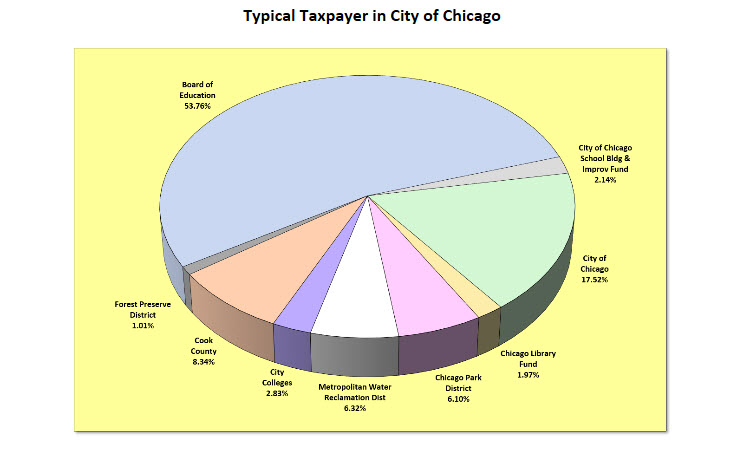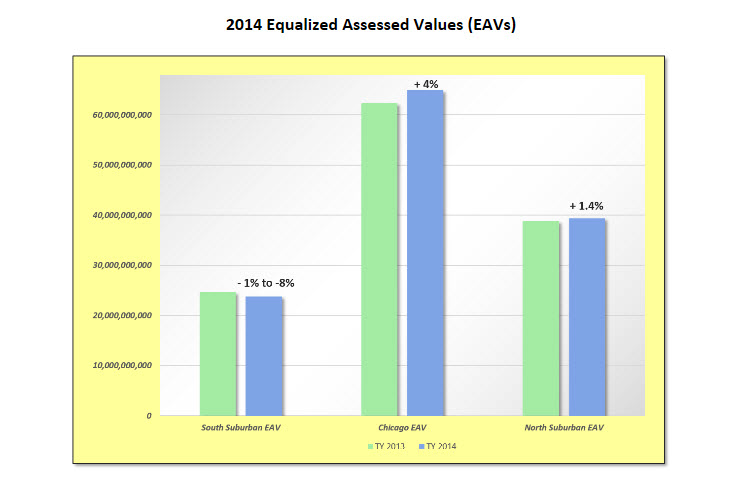Clerk Orr Releases 2014 Tax Rates
Cook County Clerk David Orr released the 2014 property tax rates for the county's more
than 1,400 taxing agencies on Thursday, the final step in the tax process before bills are
mailed out. The average homeowner in the city of Chicago and the northern suburbs will
see their tax bill increase slightly, while the average homeowner in the southern suburbs
will see a slight reduction in their tax bill.
In the south suburbs residential tax bills will on average be 1.0 percent lower. In north
suburbs there will be an average increase of 2.4 percent, and most Chicago homeowners
can expect an increase in their bill of 2.8 percent.
For the average single family home, this will translate to a decrease of $51.33 for south
suburban homeowners, an increase of $155.49 for north suburban homeowners, and a
property tax bill that is $89.44 higher than last year’s for Chicago homeowners.

Tax rates are calculated by dividing the amount of money each taxing agency or district
has requested in their levy by the total taxable value within each district. A taxing agency
or district is a body of government such as a school district, library, or municipality, which
levies real estate taxes.
The overall equalized assessed value (EAV) in Cook County has increased 1.8 percent this
year, the first time values have increased since 2009. Values in the southern suburbs,
which were reassessed this year, continued to decline, while the northern suburbs and the
City of Chicago increased.
Decreasing values in the south suburbs have contributed to increases in 2014 property tax
rates for property owners, while tax rates for the north suburbs have increased slightly and
Chicago’s remained nearly flat. The rates will be reflected in the second installment tax
bills due August 3.
A significant factor affecting the City of Chicago's tax rates was the expiration of the Near
South Tax Increment Financing (TIF) District. The Near South TIF, located near the Lake,
south of Congress Parkway, is the second-largest TIF in terms of revenue in Cook County’s
history, collecting nearly $638 million over its lifetime. With the expiration of this TIF,
nearly $1 billion in taxable value has been returned to the taxing districts. This allows the
taxing districts to increase their levies without increasing tax rates as tax revenue previously
directed to the TIF can now be collected by the taxing districts. The expiration of this TIF
district could result in approximately $65 million in tax revenue that could be shared by Chicago
districts – such as the Chicago Board of Education and the Chicago Park District – without raising
tax rates.
While City Colleges of Chicago only increased their levy by $1 million, other taxing districts with
property formerly within this TIF saw increased revenues without corresponding rate increases. The
Board of Education increased its levy by $86 million while its rate actually decreased 0.3 percent.
Of that $86 million, nearly half, $35 million, is due to the expiration of the Near South TIF.
The City of Chicago increased its levy 2.5 percent, bringing in $23 million more than last year while
reducing its rate by 1.5 percent. The Chicago Park District increased its levy 2.8 percent, increasing
their revenue by over $7 million, and like Chicago, decreasing their rate 0.3 percent.
The Metropolitan Water Reclamation District of Greater Chicago saw their rate increase 3 percent, having
increased their revenues $26 million, a 5 percent increase over last year, mostly due to an 8 percent
increase in their debt service for 2014.

"The nearly $1 billion in equalized assessed value that has been returned to the tax base with the
expiration of Chicago’s second-largest TIF district shows that taxpayers benefit when TIFs are allowed to
expire and their revenue shared," Orr said. "It illustrates how we need to keep taking a hard look at TIF
districts and work to pare down the number of TIFs, or at least the number of properties within each TIF
District."
Overall, tax rates have begun to level off after increasing steadily over the past several years, though
rates continued to increase in the southern suburbs due to declining EAVs.
As seen in the southern suburbs, an increase or decrease in the tax rate does not necessarily mean a
corresponding increase or decrease in individual tax bills. Individual tax bill amounts depend on multiple
factors including individual assessment increases or decreases, specific rate increases or decreases, and
applicable exemptions. A reduced rate applied to an increased value may result in a higher tax bill and vice
versa.
The equalization factor issued by the Illinois Department of Revenue has increased 2.4 percent from 2.6621 last
year to 2.7253 this year. IDOR calculates the factor needed to bring the total assessed value of all properties
in Cook County to a level equal to 33 1/3 percent of the total market value of all Cook County real estate.
The City of Chicago’s 2014 EAV increased 4.0 percent. Most of this increased value came from Chicago’s downtown
commercial district, where the EAV increased 10 percent due to the expiration of TIF districts, including the Near
South Tax TIF district.
EAVs in the southern suburbs declined between 1 percent and 8 percent in 2014. This is primarily due to triennial
reassessment reductions between 2 percent and 10 percent by the Cook County Assessor’s Office which offset the
increase from the 2014 Equalizer.
The 2014 EAVs in the northern suburbs increased an average of 1.4 percent. This modest growth in EAV is attributed
primarily to the 2.4 percent increase in the equalization factor, tempered by moderate reductions due to the property
tax appeal process.

The property tax rates for the south suburbs had the highest increase, at 5 percent, at the same time that rates in the
northern suburbs saw an increase of 1 percent, though rates vary considerably among jurisdictions. The City of Chicago’s
rates remained nearly flat, decreasing an average of only 0.3 percent.
The number of taxing agencies in Cook County has gone down nearly 4 percent, partly as a result of a cooperative initiative
between the Clerk’s office and municipalities to remove dormant Special Service Areas from the taxing district rolls. These
SSAs were not collecting taxes, but removing them has cleaned the rolls, taking the number of Cook County’s taxing districts
from 1,515 to 1,457.
The highest 2014 composite tax rate was 38.5 percent in the Village of Ford Heights and School District 169, where the average
home’s market value is $26,500. The lowest composite suburban tax rate – 7.2 percent – was in the Village of Barrington and Unit
School District 220, where the market value of an average home is $320,000.
The Alternative Homestead Exemption, commonly known as the "7 percent assessment cap" is now phased out in Chicago and the northern
suburbs. The maximum homeowner exemption in both of these areas is now $7,000. Although taxpayers in the southern suburbs were
eligible to receive a maximum homeowner exemption last year of $12,000, most were already at the $7,000 level because of declining
EAVs in the past several years. A small number of taxpayers in the southern suburbs were eligible to receive a larger homeowner
exemption in 2014. By tax year 2015, the Alternate Homestead Exemption will be completely phased out.
Countywide, $12,370,769,778 was billed in 2014, up 2.16 percent from $12.1 billion in 2013.
The Property Tax Extension Limitation Law (PTELL), also known as the "Tax Cap Law" limits the increase in revenue that districts may
collect to the rate of inflation. In most cases, districts this year were limited to an increase equal to the 2014 Consumer Price
Index (CPI) of 1.5 percent. Home rule districts, debt obligations, other special purpose funds, and value derived from new property
and terminated TIFs are exempt from this limitation. Next year, the CPI will limit tax revenues to an increase of 0.8 percent, the
second-lowest increase since the Tax Cap Law began over 20 years ago.